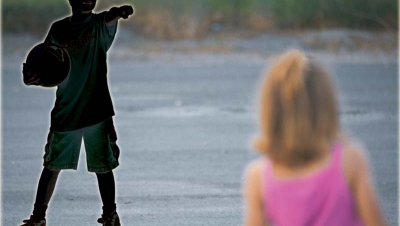Stopping Bullies On The Playground
When bullying occurs, the most likely venue, especially in primary schools, is the school playground. This illustrates the darker side of recess." Whitney and Smith (1993)
Outdoor play environments are social places. Children take advantage of the free time to play games with their friends or to simply sit and chat. But with this social bliss also comes the presence of aggression - bullying.
Bullying is a common occurrence on nearly all playgrounds. More than 50 percent of children report bullying either in middle or secondary schools. One in five children reporting bullying on a daily basis. Bullying is a form of aggressive performance by one or more children that involves negative behaviors (e.g., rude gestures, ugly faces, teasing, name-calling, exclusion from play opportunities, and physical contact) toward other children.
Theories regarding the motivation for bullying include personal aggressive tendencies, emotional temperament, lack of well-developed social skills, and victims' nonassertive behavior. Other theories suggest misinterpretation of play invitations, lack of regard for the reactions/feelings of peers, and an extremely large amount of time spent alone. Bullying tendencies demonstrated early in life are considered to be significant predictors of antisocial behaviors in adulthood. The recipient of the bullying can also have long-term consequences in that he or she may suffer physically, academically or psychologically into adulthood.
Play supervisors must be careful in their evaluation of play and bullying. Teachers often have difficulty recognizing bullying when it occurs. This misinterpretation can lead to teachers stopping play fighting or rough and tumble play, which is not bullying and allowing teasing and name calling because name calling is often an ambiguous event. Interpreting verbal bullying can be difficult. Most verbal bullying and name calling on the playground focuses on children's physical appearance. Teasing about physical appearance can be especially significant for girls in that it has been associated with a higher occurrence of body image and eating disorders for women. On the other hand, nicknames are not necessarily perceived as malicious and can be part of the development of social bonds.
Most children who are victims of verbal bullying neither seek assistance from adults nor report the behavior. Teachers who are unsure about whether a name-calling event is bullying or not should speak directly with the child to ask his or her interpretation.
Physical bullying can also be hard to interpret. Bullying is often confused with rough and tumble play (R&T). R&T play, which accounts for approximately 17 percent of school-age children's play, has developmental value for young children. For example, R&T play can assist in developing the skills needed to participate in other types of play. R& T play is a form of play that involves a great deal of physical contact between players, such as wrestling, but it is appropriate in that all players are agreeing to the play. Children involved in bully situations, however, do not agree with the physical contact.
A second significant difference between contact during R&T play and bullying is found in the hands. When children are wrestling, they will typically have open hands, touching their play partner in a non-violent gesture. Bullies will have closed hands wrapped in a fist to dominate the other child.
Thirdly, the behavior exhibited by children involved will signal the type of situation that is being experienced. During R&T play, the children involved will cooperate in the running, chasing, fleeing and wrestling. They will alternate in their roles, such as chaser to chasee, and will leave the play space together to move on to another play activity. In aggressive situations the children involved will separate immediately upon the end of the interaction and will not participate in switching roles.
Although it is important that teachers and adults allow children to work out their own problems, when intervention is not applied in bullying situations it appears to the participants that the behavior is condoned. Ways teachers may reduce the presence of bully/victim incidents include:
(1) playground supervision;
(2) developing clear rules against bullying behaviors;
(3) alerting parents to their child's aggressive behavior;
(4) educating children with strategies to get them all involved with efforts to end bullying;
(5) and teaching victims how to assert themselves. Teachers should find a balance between allowing children to play freely and being pro-active in the steps to reduce overtly dangerous activities and bullying behaviors.
POST ARTICLE NOTES:
The research done for production of this article is sponsored by IPEMA.
References
- Aho, S. (1998). The teasers and the teased pupils at school. Scandinavian Journal of Educational Research, 42, 309-318.
- Crozier, W. & Sklipidou, E. (2002). Adult recollections of name-calling at school. Educational Psychology, 22 (1), 113-124.
- De Klerk, V. & Bosch, B. (1996). Nicknames as sex role stereotypes. Sex Roles, 35, 525-541.
- Frost, J. L., Wortham, S. & Reifel, S. (2001). Play and child development. Upper Saddle River, NJ: Merrill Prentice Hall.
- Johnson, J. E., Christie, J. F. & Yawkey, T. D. (1999). Play and early childhood development: Second edition. NY: Longman.
- Keltner, D., Young, R., Heery, E., Oemig, C., & Monarch, N., 1998). Teasing in hierarchical and intimate relations. Journal of Personality and Social Psychology, 75, 1231-1247.
- Olweus, D. (1993). Bullies on the playground: The role of victimization. In C. Hart (Ed.), Children on playgrounds: Research perspectives and applications (85-128). Albany, NY: State University of New York Press.
- Pellegrini, A. D. & Perlmutter,). (1986). The developmental and social significance of children's rough-and-tumble play. American Educational Research Association. (April). San Francisco.
- Pelligrini, A. D. & Smith, P. K. (1993). School recess: Implications for education and development. Review of Educational Research, 63, 51-69.
- Perry, J.P. (2001). Outdoor play: Teaching strategies with young children. NY: Teachers College Press.
- Schantz, D. W. (1986). Conflict, aggression, and peer status: An observational study. Child Development, 57, 1322-1332.
- Schafer, M. & Smith, P. K. (1996). Teachers' perceptions of play fighting and real fighting in primary school. Educational Research, 38, 173-181.
- Thorne, B. (1993). Gender play: Girls and boys in school. NJ: Rutgers University Press.
- Whitney, I. & Smith P. K. (1993). A survey of the nature and extent of bully/victim problems in junior/middle and secondary schools. Educational Researcher, 25, 72-85.





Add new comment